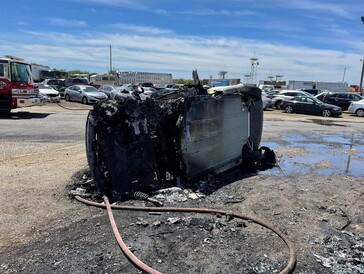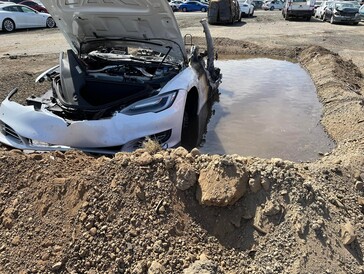Original article.
Daniel Zlatev, 🇫🇷 🇪🇸 … E-Mobility
Firefighters across the globe are facing a new problem with burning electric cars – they can’t easily be put out – and require many times the amount of water and efforts to extinguish. A case in point is a wrecked Tesla sitting in a junkyard for weeks before it spontaneously combusted and the fire brigade couldn’t kill the flames with their current toolkit.
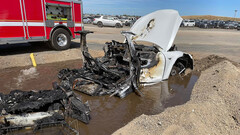
A number of fire departments across the globe are starting to realize that electric cars will be one unexpected challenge to put out because of their spontaneously combusting battery compartments. While there are already tools on the market to deal with EV fires, unexperienced fire brigades that get called to an EV incident for the first time learn that they will need new solutions the hard way.
In one such case, the Sacramento Metropolitan Fire department headed to a call from a junkyard that they had a burning Tesla which suddenly caught on fire after sitting still for weeks on end. After burning through exorbitant amounts of water, the fire brigade quickly realized they can’t put out the flaming battery the traditional way, and dunked the whole undercarriage in a pool of water to stop the Tesla fire:
The vehicle was involved in an accident 3 weeks ago, sustained major damage, and was parked in a wrecking yard for dismantling. The vehicle was fully involved with fire on arrival, and took a significant amount of time, water, and thinking outside the box to extinguish.
Crews knocked the fire down, but the car kept re-igniting and off-gassing in the battery compartment. Working with the on-site wrecking yard personnel, the Tesla was moved on its side to gain access to the battery compartment underneath. Even with direct penetration, the vehicle would still re-ignite due to the residual heat.
Crews and on-site personnel then created a small pit, placed the car inside it, and filled the pit with water effectively submerging the battery compartment. The pit ultimately reduced the total amount of water needed, estimated at 4500 gallons, and limited the runoff of contaminated water. The vehicle was fully extinguished, and no injuries were reported.
Back in February, a set of electric Porsches on the Felicity Ace cargo ship wreckage caught on fire, couldn’t be extinguished by the SMIT Global rescue firm, and their battery flames were only put out when the ship eventually sank.
The Tesla EV accidents where the battery catches on fire, however, can be resolved easier with a dedicated tool by the Austrian firefighting tools company Rosenbauer (PDF). Their contraption puts high-pressure nozzles facing the undercarriage which pierce the battery’s packaging and douse its cells directly.
While waiting for such tools to become mainstream, however, the Rocklin Firefighters school only shared the burning Tesla experience of the Sacramento firefighters with the comment “The future is going to be tricky!”
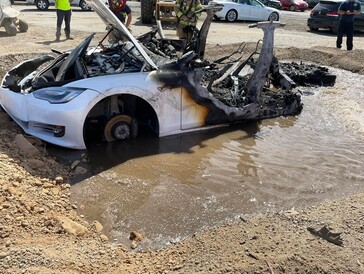
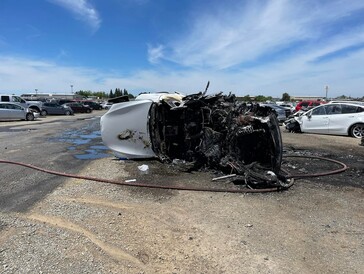
https://www.facebook.com/watch/?v=3181882308691712
Source(s)
Sacramento Metropolitan Fire District
Electric vehicle fires can take 3,000 gallons and 24 hours to extinguish
Original article.
Posted on, CategoriesUncategorized
Tesla has produced a guide for first responders
Electric vehicles with lithium-ion batteries present a complex and hazardous situation for firefighters responding to a vehicle accident. If a conventional vehicle with gasoline or diesel catches fire after an accident it usually happens quickly and is very evident. When batteries in an electric car are damaged by debris on the road or a collision, a short circuit can occur in one or more of the thousands of cells, creating heat which may ignite the chemicals inside the battery. This can spread to the adjoining cells and lead to the condition known as “thermal runaway” in which the fire escalates.
Independent research and information for first responders produced by Tesla warn that a battery fire in an electric vehicle can take 3,000 gallons of water and up to 24 hours to fully suppress. Firefighters should immediately arrange for water tenders and use a master stream if possible. Consider allowing the battery to burn while protecting exposures. Breathing apparatus is absolutely required. In some cases firefighters have run out of air and had to get a second bottle.

If the fire appears to be out, a thermal imaging camera can help to identify any areas still burning or overheated. In one test a battery reignited the vehicle 22 hours later. Tesla recommends that after a fire their vehicles should be stored at least 50 feet away from any combustible material.
Their new Model 3 has two “cut loops” that firefighters can sever to shut down the high voltage system outside of the high voltage battery and disable the supplemental restraint system and airbag components.

Thanks and a tip of the hat go out to Bean.
** End **
